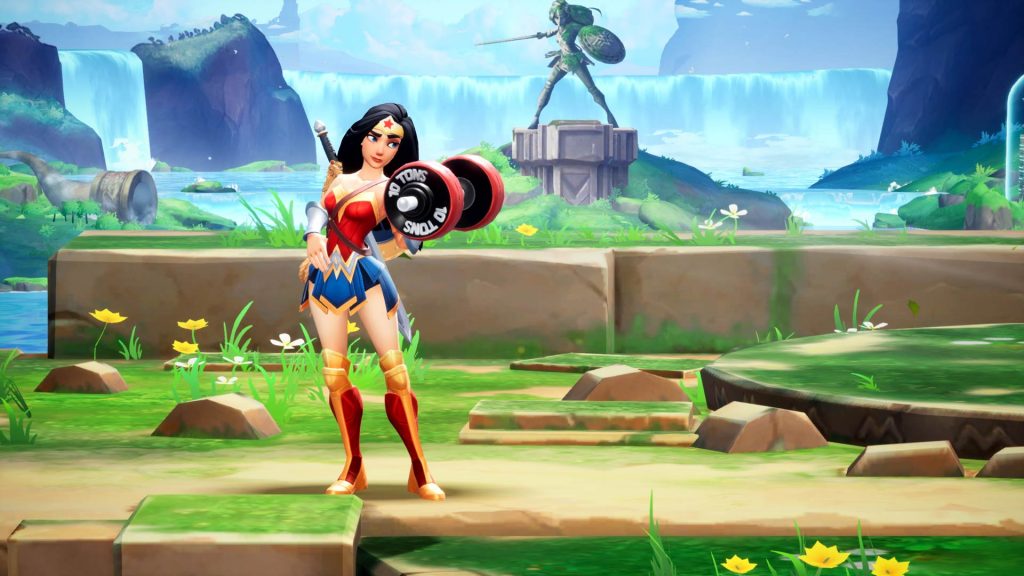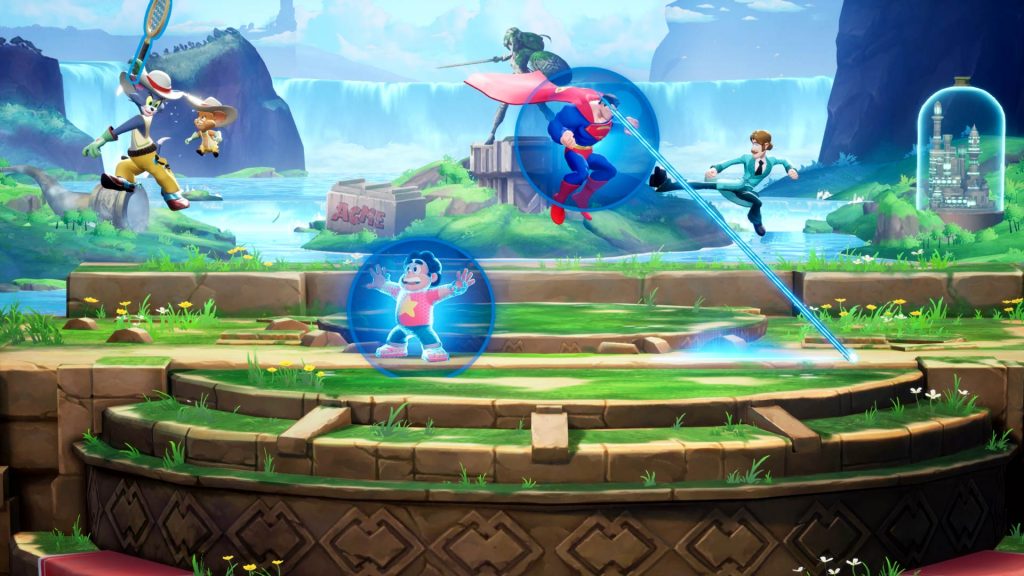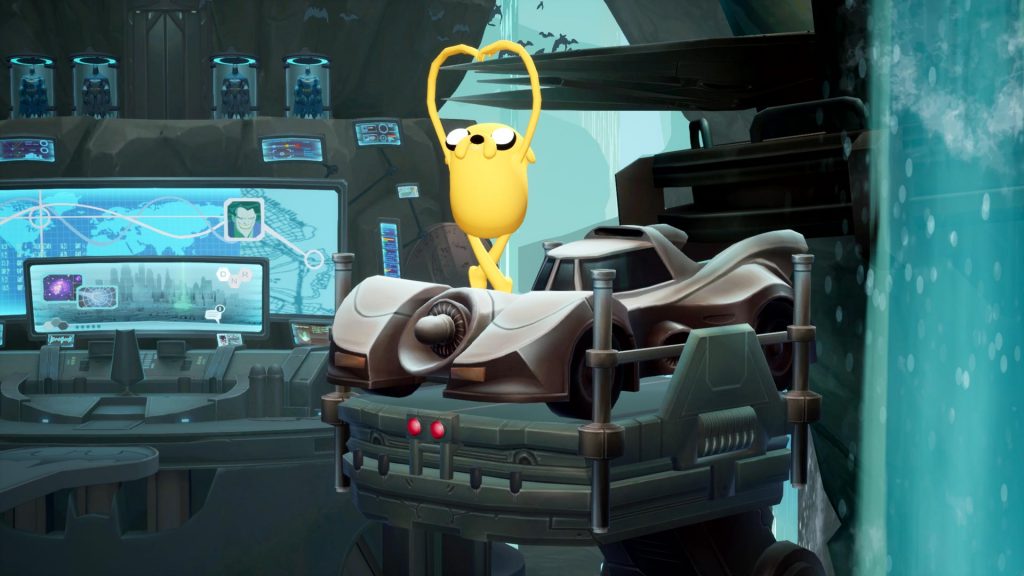Here Comes a New Challenger
For the longest time, the Super Smash Bros. series had a monopoly on the fighting game sub-genre that has now come to be known as the platform fighter, where elements of both platformers and fighting games combine. There were a few modest attempts to expand upon it, but the genre didn’t really begin to flourish until around the time of the fourth Smash installment, and even then most of the other games were more niche indie-developed titles or licenced shovelware. However, in recent years, as popularity for alternatives has increased and many games have found success, more publishers have been willing to fund bigger budget titles, with the most recent of these being Warner Bros.’ first foray into the platform fighter scene, the free-to-play ‘MultiVersus’.
MultiVersus, on the surface, may look a lot like Smash Bros., but it does play differently. The gameplay, like in Smash, involves defeating opponents by knocking them off-screen, which can be done by raising their damage to high percentages, but that’s where the similarities end. For one, MultiVersus lacks grabs and shielding/blocking, with dodging being the only defensive manoeuvre in the latter’s case. The lines between normal and special attacks have been blurred in many cases, and many characters have completely different special moves in the air compared to when used on the ground. There is also an increased focus on air mobility and time that can be spent in the air; characters are able to jump twice (or once if knocked off-stage), use two special moves, and two air dodges before running out of movement options in mid-air. In addition to this, characters can climb up walls on the sides of the stages as a trade-off for not being able to grab ledges. This, combined with the air movement options, means not only do characters have more ways to make it back to the stage, meaning ring-outs are less likely to occur from running out of recovery options, but it also means that fighters can spend more time off-stage, encouraging players to take more of an offensive approach and chasing fighters they’ve knocked off stage to ensure they won’t make it back.

Better with a Friend
The game has also set out to carve its own distinct niche by focusing on 2v2 matches. While this kind of battle has been possible in other platform fighters, Player First Games has gone out of their way to fully realise its potential. In battle, fighters can assist their teammates in various ways, from buffing their stats to providing movement options and even being able to save them from falling to their doom. These features really help to encourage teamwork and ensure that focusing on 2v2 is more than a mere gimmick. In addition to this, unlike other fighters, in this game’s 2v2 mode, stocks are shared between team members instead of each fighter having individual lives. Because of this, teams can’t whittle down the opposing one into just having one opponent by depleting the other opponent’s lives first; this approach discourages ganging up on one fighter and further strengthens the focus on teamwork that Player First Games is aiming for.
Traditional 1v1 and 4 player Free-For-All matches are also available in the game, and the former functions just as well as 2v2. The movesets have been designed in a way that they feel complete even when they can no longer be used for assisting teammates, which means the focus on 2v2 has been no detriment to the more traditional 1v1 matches. Sadly, the Free-For-All mode is kind of weak and feels more like an afterthought, despite platform fighters being made for this kind of play. Instead of involving stocks, the goal of this mode is to have the most KOs before time runs out, and the stage’s borders close in as the timer begins to run low, making the fight more cramped. It is likely that options for this mode like stock-based matches and no shrinking borders will be added in the future, but as of now it is definitely the weakest of the match types and the one I played the least.
Hands-on with the Alpha
The Closed Alpha is a primarily online experience. Not only can the game only be accessed online even while not in multiplayer, but there are very few single-player options in the game. The player can fight against a CPU opponent in a 1v1 match, or experiment in The Lab, which is the game’s training mode. Fortunately, Player First Games have prioritised the online experience, ensuring the game has a good netcode and utilising Rollback instead of the more common Peer-to-Peer system present in a lot of fighting games. While there was the occasional issue every now and then, the online experience was very smooth for the most part, and with the game only being in alpha at this point, it’s safe to say that the game will have more than competent online when it reaches full release.

Classes of Their Own
Characters in MultiVersus are categorised into classes that give an idea of their general playstyle, though these classifications aren’t very strict and there is a lot of variety within them. Bruisers are generally all-around fighters with plenty of melee attacks and don’t have a particular area of specialization. Assassins are faster characters that tend to favour a weapon and excel at close-range attacks and combos. Mages are a ranged class that can keep their distance from opponents with projectiles and traps, while support class fighters have a lot of moves that can assist their teammates as well as create safe areas for themselves on stages. Finally, there is the Tank class, which features characters who are more durable than other fighters and have armour on many of their attacks.Characters are also given a second type of classification in-game as to whether they excel at attacking on the ground and to the sides, or at aerial fighting and attacks covering above and below. These classifications are designated as “horizontal” and “vertical,” with fighters who can excel at both being labelled as “hybrid.”
Playing matches gains XP for the characters you’ve played as, which allows them to level up and unlock customisation options for them. These include skins, taunts, profile icons, and even announcer voice lines. Characters can also be tweaked with unlockable perks. Characters can equip up to four different perks that can change their attributes in battle, including one slot that can be filled by one of several signature perks exclusive to each character. Regular perks are universal amongst the roster and tend to involve subtle boosts to different stats or reducing cooldowns on moves, amongst other traits, whereas Signature Perks tend to add a more noticeable change or addition to one of a character’s moves or abilities, usually one of their specials. In 2v2 matches, if both players on the same team equip the same perk, the benefits of that perk are increased even further, yet another way the game encourages teamwork between players. Tony Huynh, the game director for MultiVersus, has confirmed that perks will only be unlocked through gameplay in the final game, meaning that players won’t have to worry about perks being used for micro-transactions as some sort of pay-to-win system.

Where the game’s free-to-play nature comes in is the Battle Pass. Like many other games with a multiplayer online experience, MultiVersus will include Seasons accompanied by a Battle Pass. Playing matches, winning battles, and completing challenges will grant you premium tokens (functionally the same as XP for characters) that unlock rewards upon reaching the end of each tier. As with levelling up characters, ranking up tiers in the Battle Pass unlocks new skins, taunts, and profile icons, but also content that can’t be unlocked by the former method, such as banners, animated emotes, and ringout animations. The Battle Pass features two rows, a free row and a premium row, the latter of which’s unlocks need to be paid for with real money (though in the Closed Alpha, these unlocks were also free). As there are no microtransactions in the Closed Alpha, it is yet to be seen how well this game’s monetization model will turn out, though the developers have promised that all characters and stages will be unlockable through regular gameplay without having to spend money.
Come Join the Warner Brothers
For those who have seen the game already and are wondering what the correlation between all these seemingly unrelated franchises is, the game is a crossover between IPs owned by Warner Bros. The currently-revealed roster spans many of the company’s vast brands, ranging from Cartoon Network to Hanna-Barbera to DC Comics. Iconic cartoon characters like Bugs Bunny, Tom & Jerry, and Finn from Adventure Time are all playable and can team up or duke it out with superheroes like Batman and Wonder Woman, and perhaps most bizarrely, Arya Stark from Game of Thrones. Characters are fully voiced with dialogue provided by a large cast of professional voice actors, and the majority of them are reprised by their original or most iconic VAs, like Kevin Conroy as Batman.
Characters acknowledge each other in dialogue, and there are a lot of fun interactions between characters, both from the same franchises and others. The roster isn’t simply just a line-up of WB properties with appearances and voices, though; each character has their own gameplay style that Player First Games has crafted to make you really feel like you are playing as these characters. At the same time, Batman is good at fistfights but also has a wealth of gadgets he can rely on. Jake the Dog can stretch his limbs to attack from afar as well as shapeshift into all sorts of objects, and Tom & Jerry’s moveset brilliantly revolves around Tom trying to attack Jerry but missing and hitting opponents in the process. These movesets truly take advantage of the iconic characters in this game’s line-up, instead of them merely being familiar faces with generic similar playstyles to each other.

Stages with Character
In platform fighters, stages are just as important to the experience as the characters are, and in MultiVersus, this is no different. While not having many so far, the Closed Alpha featured several playable stages that are all distinctive from each other in both aesthetic and design, and like the roster itself, the stage line-up features several iconic locations. The Batcave features retractable platforms carrying Batmobiles and swarms of bats while being home to many details comic fans will recognise in the background, whereas the Tree Fort from Adventure Time is a more vertical stage with destructible branches that can be bounced off. The last of these classic locales is the Haunted Mansion stage from Scooby-Doo, with a very unique mostly-indoor layout and gears that can make parts of the floor move off-stage when hit. There is also a training stage that has several variants, with and without platforms, as well as the original location of Trophy’s E.D.G.E., set in a rich landscape adorned with objects from the many different worlds involved in this crossover. Several stages have alternate versions that adjust their sizes and layout to be more suited to 1v1 as well, and the Trophy’s E.D.G.E. stage features two different variants in layout too, providing many options for stages beyond the current five locations.
MultiVersus features an original orchestrated soundtrack, befitting of a WB production. The menu songs are composed to fit the mood well, with the main menu theme being peaceful and relaxed, perfect for browsing your collection or the options menu; meanwhile, the character select theme is rather triumphant, motivating the player to join the battle. MultiVersus also takes a page from Super Smash Bros.’ book and features several remixes of classic and memorable songs from many of the franchises featured, with the Batcave including an arrangement of Danny Elfman’s iconic Batman theme, while the Tree Fort stage comes with an orchestrated cover of Adventure Time’s credits song “Come Along With Me”. The music for these stages is also dynamic, with different songs that come in once a battle approaches its match point.

Conclusion
From my time spent with the Closed Alpha alone, MultiVersus is already shaping up to be a promising game. Not only does it set out to bring something new to the genre and provide a robust online experience (something that isn’t as common in fighters as it should be), but it also promises an approach to the free-to-play model that isn’t exploitative of its players, which could set a precedent for how other fighting games approach monetization in the future, free-to-play or otherwise.
Player First Games are living up to their name, offering a wealth of customisation options to tailor the game to the player’s experience, as well as addressing some of the complaints people have had with other games within the sub-genre. There is clearly passion behind the game, and care has gone into each character to ensure they truly represent the characters we know and love; this is no mere throwaway licenced cash-in.
MultiVersus is a game I’d definitely recommend for fans of platform fighters to keep an eye on, and there is currently an Open Beta for the game that anyone can play right now until August 16th, when the full game launches. Whether you’ve played a game like this before or not, if you are interested, then give it a try. It’s free, after all!


Leave a Reply